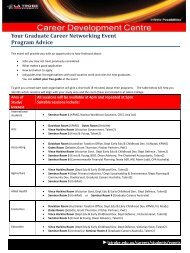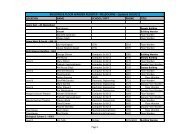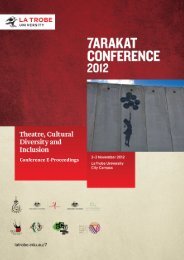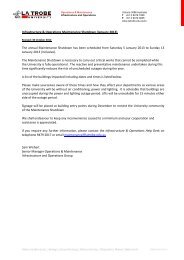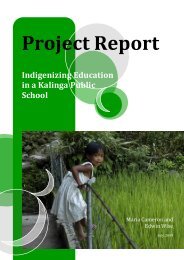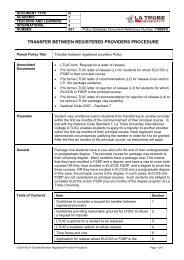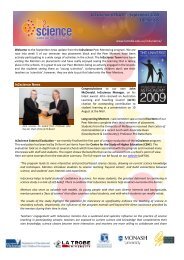Water Snail Damselfly - La Trobe University
Water Snail Damselfly - La Trobe University
Water Snail Damselfly - La Trobe University
Create successful ePaper yourself
Turn your PDF publications into a flip-book with our unique Google optimized e-Paper software.
<strong>Water</strong> <strong>Snail</strong><br />
Class Gastropoda<br />
<strong>Water</strong> snails are molluscs. They have small<br />
horny teeth that they use to feed on water<br />
plants and algae by scaping it off hard<br />
surfaces such as rocks and logs. They have a<br />
coiled shell and grow up to 2 centimetres in<br />
length. These snails breathe air and fill their<br />
lungs with oxygen when they come to the<br />
surface of the water. They lay their jelly-like<br />
eggs in groups on rocks or the leaves of water<br />
plants.<br />
<strong>Water</strong> snails are hermaphrodites. That<br />
means that they are neither boys or girls<br />
and can fertilise their own eggs!<br />
<strong>Damselfly</strong><br />
Order Odonta<br />
Suborder Zygoptera<br />
Damselflies look similar to dragonflies except<br />
they are smaller and have more slender<br />
bodies. Their larvae are aquatic and have<br />
three gills at the end of their bodies that look<br />
like tails. Their large eyes help them to find<br />
and catch other water animals hiding between<br />
water plants and in leaf litter. Adult<br />
damselflies mainly eat flying insects that they<br />
catch near the surface of the water.<br />
More then 80 per cent of a damselfly’s<br />
brain is used to make sense of things that<br />
it sees through its eyes!<br />
*All photos are taken from “Hawking, J.H. and Smith, F.J. (1997). Colour Guide to Invertebrates of Australian<br />
Inland <strong>Water</strong>s (Identification Guide No.8). The Co-operative Research Centre for Freshwater Ecology, Albury.”
Dragonfly<br />
Oder Odonta<br />
Suborder Anispotera<br />
Dragonfly larvae are sometimes called<br />
mudeyes. They live on the bottom of<br />
freshwater ponds and creeks, feeding on other<br />
water animals that they catch by shooting out<br />
their lower lip and dragging them in. When<br />
the larvae are ready to turn into an adult<br />
dragonfly, they climb up a water plant and<br />
shed their skin before flying off. Dragonflies<br />
have been found as fossils more than 300<br />
million years old.<br />
Adult dragonflies can fly at up to 50 km<br />
per hour. They dart around above the<br />
water to catch flying insects.<br />
Stonefly<br />
Order Plecoptera<br />
Stonefly larvae live on the bottom of<br />
freshwater streams and ponds and can often<br />
be found resting on stones of fast-flowing<br />
streams. The larvae are streamlined and<br />
have claws on the ends of their feet so they<br />
don’t get swept away. Most stonefly nymphs<br />
feed on algae and dead plants while a few are<br />
predators and feed on other water animals.<br />
Many adult stoneflies only live for a few days<br />
and some don’t even eat before they die!<br />
Female stoneflies live longer than males.<br />
*All photos are taken from “Hawking, J.H. and Smith, F.J. (1997). Colour Guide to Invertebrates of Australian<br />
Inland <strong>Water</strong>s (Identification Guide No.8). The Co-operative Research Centre for Freshwater Ecology, Albury.”
Backswimmer<br />
Order Hemiptera<br />
Family Notonectidae<br />
Backwimmers are predators, feeding on<br />
smaller water bugs such as bloodworms and<br />
insect larvae as well as insects resting on the<br />
surface of the water. They breathe under<br />
water by storing a bubble of air on the<br />
underside of their body. If their watery home<br />
becomes polluted or dries up, backswimmers<br />
can fly to another pond or river.<br />
<strong>Water</strong> Boatman<br />
Order Hemiptera<br />
Family Corixidae<br />
Backswimmers get their name from their habit of<br />
swimming upside down at the surface of the water.<br />
Be careful because they can give you a nasty nip!<br />
<strong>Water</strong> boatmen live amongst vegetation in<br />
ponds and slow-flowing streams. These bugs<br />
look similar to backswimmers except they<br />
swim upright and prefer to feed at the bottom<br />
of their habitat. They have sucking<br />
mouthparts and feed on insects as well as<br />
dead plants and animals in mud and leaf litter.<br />
<strong>Water</strong> boatmen move through the water using<br />
swimming hairs on their middle and back legs.<br />
While resting, water boatmen cling to objects in<br />
the water such as rocks and logs. Some even<br />
hitch a ride on live fish!<br />
*All photos are taken from “Hawking, J.H. and Smith, F.J. (1997). Colour Guide to Invertebrates of Australian<br />
Inland <strong>Water</strong>s (Identification Guide No.8). The Co-operative Research Centre for Freshwater Ecology, Albury.”
<strong>Water</strong> Tiger<br />
Order Coleoptera<br />
Family Dytiscidae<br />
<strong>Water</strong> tigers are the larvae of diving beetles<br />
that live on the edges of streams and ponds.<br />
They have a snorkel on the end of their bodies<br />
that they stick out of the water to breathe.<br />
Adult diving beetles breathe by storing air<br />
under their wings. <strong>Water</strong> tigers feed on other<br />
aquatic animals by injecting digestive fluids<br />
into their prey and sucking out the liquefied<br />
insides! Adults also eat water animals and will<br />
even catch tadpoles and small fish. <strong>Water</strong><br />
tigers begin life as eggs which the female<br />
beetles deposit in the stems of water plants.<br />
Adult diving beetles fly from one water source to another by<br />
looking for light reflected off the surface by the moon.<br />
Sometimes they get confused and fly into street lights or the<br />
headlights of cars!<br />
Bloodworm<br />
Order Diptera<br />
Family Chironomidae<br />
Bloodworms live in sludge on the bottom of<br />
ponds and streams. They can survive in<br />
water that is low in oxygen and are very<br />
tolerant of pollution. They generally feed on<br />
dead plants and animals while a few eat only<br />
plants. Most bloodworms are free-living while<br />
some live in silken tubes in the mud.<br />
Bloodworms are red in colour because they<br />
contain a substance called haemoglobin. This is<br />
a blood protein that carries oxygen.<br />
*All photos are taken from “Hawking, J.H. and Smith, F.J. (1997). Colour Guide to Invertebrates of Australian<br />
Inland <strong>Water</strong>s (Identification Guide No.8). The Co-operative Research Centre for Freshwater Ecology, Albury.”
Caddis Fly<br />
Order Tricoptera<br />
The aquatic larvae of these flies enclose<br />
themselves in cases of sand grains, twigs or<br />
pebbles sown together with silken thread.<br />
Others hide in hollow stems of reeds and<br />
sedges while a few are free-swimming. Most<br />
caddis fly larvae are found living on the bottom<br />
of flowing creeks and rivers where they can<br />
collect bits of algae and other plant material to<br />
eat. The adult flies have wings and live on<br />
land, usually near the water.<br />
Mayfly<br />
Order Epmeroptera<br />
Like damselflies, mayfly nymphs have three<br />
filaments, like tails on the end of their bodies.<br />
They live under rocks and amongst plants in<br />
rivers and creeks and feed on live or decaying<br />
plant matter. The larvae breathe underwater<br />
using gills and can take up to two years to<br />
become adults. Adult mayflies have two pairs<br />
of see-through wings and mate while flying.<br />
Flat Worm<br />
Class Turbellaria<br />
Some caddis fly larvae in urban areas choose to build<br />
their homes out of man-made structures such as drink<br />
straws, pen lids and even lolly wrappers!<br />
These flattened worms are common in<br />
freshwater ponds and streams and have a<br />
triangular-shaped head. They slide along the<br />
bottom of their habitat, preying on other<br />
invertebrates and scavenging on dead<br />
animals. Some are parasites and feed off<br />
larger animals. As well as reproducing<br />
normally, flatworms can split themselves in<br />
two, creating a new worm! This is called<br />
asexual reproduction.<br />
Adult mayflies live for no longer than 24 hours! They don’t<br />
feed at all and mate as soon as they emerge from the water.<br />
Flatworms don’t have bottoms so they<br />
get rid of waste through their mouths!<br />
*All photos are taken from “Hawking, J.H. and Smith, F.J. (1997). Colour Guide to Invertebrates of Australian<br />
Inland <strong>Water</strong>s (Identification Guide No.8). The Co-operative Research Centre for Freshwater Ecology, Albury.”


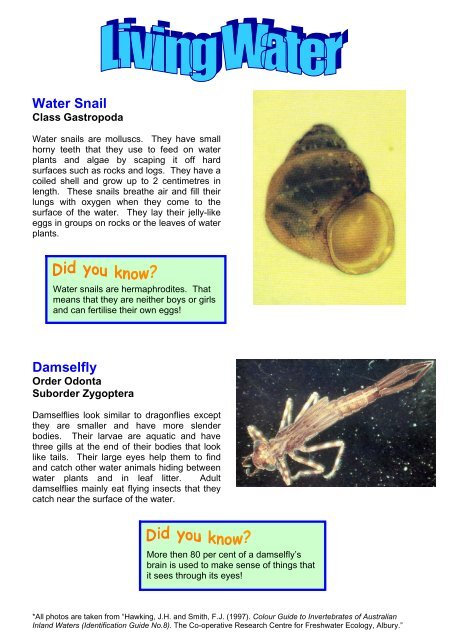
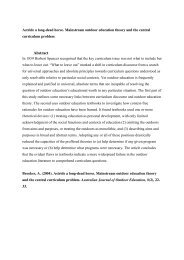
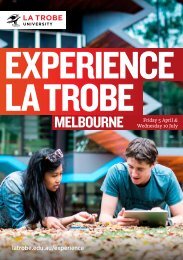
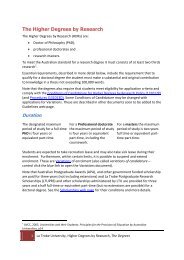
![Ottoman Empire course brochure [PDF 612KB] - La Trobe University](https://img.yumpu.com/12001562/1/184x260/ottoman-empire-course-brochure-pdf-612kb-la-trobe-university.jpg?quality=85)
![Getting Ready to Talk Manual [PDF 315KB] - La Trobe University](https://img.yumpu.com/11430807/1/190x245/getting-ready-to-talk-manual-pdf-315kb-la-trobe-university.jpg?quality=85)
